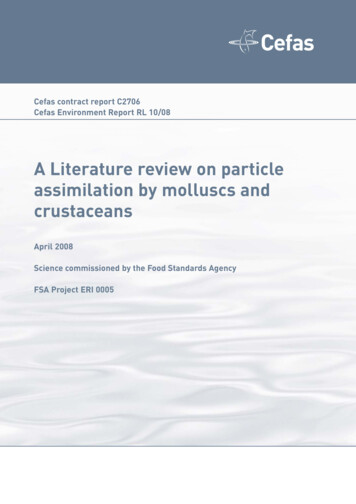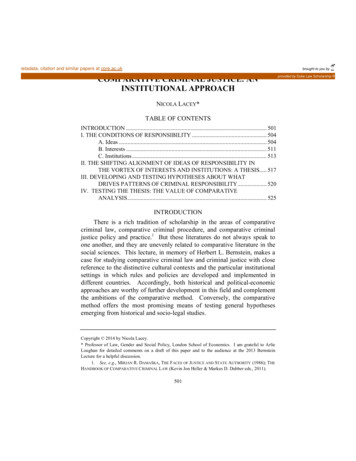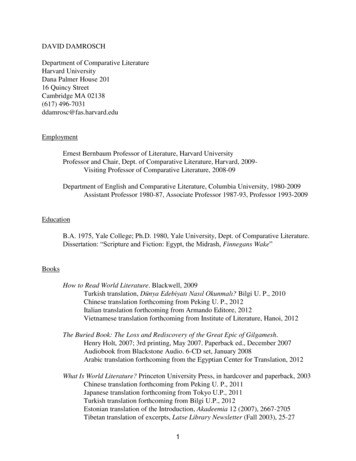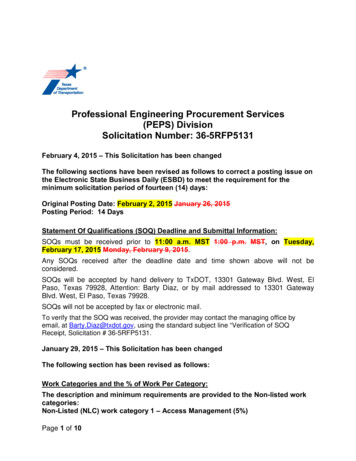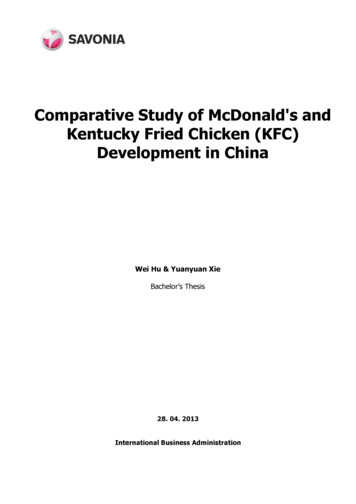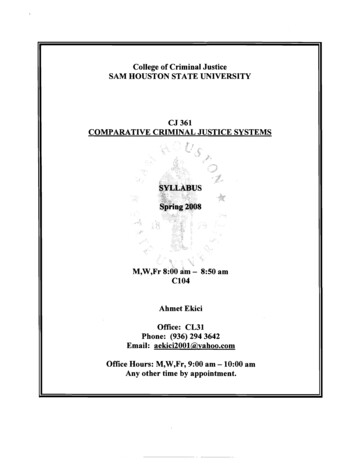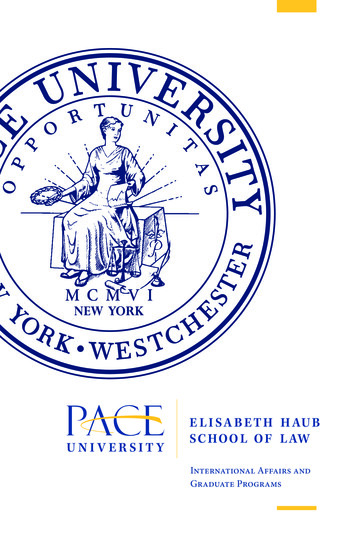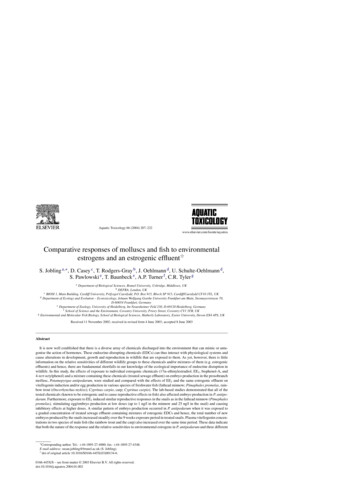
Transcription
Aquatic Toxicology 66 (2004) 207–222Comparative responses of molluscs and fish to environmentalestrogens and an estrogenic effluent夽S. Jobling a, , D. Casey c , T. Rodgers-Gray b , J. Oehlmann d , U. Schulte-Oehlmann d ,S. Pawlowski e , T. Baunbeck e , A.P. Turner f , C.R. Tyler gaDepartment of Biological Sciences, Brunel University, Uxbridge, Middlesex, UKb DEFRA, London, UKc BIOSI 1, Main Building, Cardiff University, Prifysgol Caerdydd, P.O. Box 915, Blwch SP 915, Cardiff/Caerdydd CF10 3TL, UKd Department of Ecology and Evolution – Ecotoxicology, Johann Wolfgang Goethe University Frankfurt am Main, Siesmayerstrasse 70,D-60054 Frankfurt, Germanye Department of Zoology, University of Heidelberg, Im Neuenheimer Feld 230, D-69120 Heidelberg, Germanyf School of Science and the Environment, Coventry University, Priory Street, Coventry CV1 5FB, UKg Environmental and Molecular Fish Biology, School of Biological Sciences, Hatherly Laboratory, Exeter University, Devon EX4 4PS, UKReceived 11 November 2002; received in revised form 4 June 2003; accepted 8 June 2003AbstractIt is now well established that there is a diverse array of chemicals discharged into the environment that can mimic or antagonise the action of hormones. These endocrine-disrupting chemicals (EDCs) can thus interact with physiological systems andcause alterations in development, growth and reproduction in wildlife that are exposed to them. As yet, however, there is littleinformation on the relative sensitivities of different wildlife groups to these chemicals and/or mixtures of them (e.g. estrogeniceffluents) and hence, there are fundamental shortfalls in our knowledge of the ecological importance of endocrine disruption inwildlife. In this study, the effects of exposure to individual estrogenic chemicals (17 -ethinylestradiol; EE2 , bisphenol-A, and4-tert octylphenol) and a mixture containing these chemicals (treated sewage effluent) on embryo production in the prosobranchmollusc, Potamopyrgus antipodarum, were studied and compared with the effects of EE2 and the same estrogenic effluent onvitellogenin induction and/or egg production in various species of freshwater fish (fathead minnow; Pimaphales promelas, rainbow trout (Oncorhynchus mykiss); Cyprinus carpio, carp; Cyprinus carpio). The lab-based studies demonstrated that all of thetested chemicals (known to be estrogenic and to cause reproductive effects in fish) also affected embryo production in P. antipodarum. Furthermore, exposure to EE2 induced similar reproductive responses in the snails as in the fathead minnow (Pimephalespromelas), stimulating egg/embryo production at low doses (up to 1 ng/l in the minnow and 25 ng/l in the snail) and causinginhibitory effects at higher doses. A similar pattern of embryo production occurred in P. antipodarum when it was exposed toa graded concentration of treated sewage effluent containing mixtures of estrogenic EDCs and hence, the total number of newembryos produced by the snails increased steadily over the 9 weeks exposure period in treated snails. Plasma vitellogenin concentrations in two species of male fish (the rainbow trout and the carp) also increased over the same time period. These data indicatethat both the nature of the response and the relative sensitivities to environmental estrogens in P. antipodarum and three different Corresponding author. Tel.: 44-1895-27-4000; fax: 44-1895-27-4348.E-mail address: susan.jobling@brunel.ac.uk (S. Jobling).夽 doi of original article 10.1016/S0166-445X(03)00134-6.0166-445X/ – see front matter 2003 Elsevier B.V. All rights reserved.doi:10.1016/j.aquatox.2004.01.002
208S. Jobling et al. / Aquatic Toxicology 66 (2004) 207–222fish species fish are comparable. P. antipodarum is thus, potentially a sensitive test organism for assessing estrogenicity ofchemicals with a relevance to their activity in vertebrates. 2003 Elsevier B.V. All rights reserved.Keywords: Snails; Prosobranch; Estrogen; Fish; Ethinylestradiol1. IntroductionEnvironmental estrogens are chemical pollutantsthat can disrupt the endocrine system of animals bybinding to and activating the estrogen receptor(s).They include both natural and synthetic steroid estrogens, as well as a variety of estrogen-mimickingchemicals, such as 4-nonylphenol, bisphenol-A(BPA) various plasticizers, herbicides and pesticides(Colborn et al., 1993). It is now generally acceptedthat endocrine-disrupting chemicals (EDCs), including environmental estrogens, are at least partiallyresponsible for disruption of reproduction and development in some wildlife populations (Tyler et al.,1998; Vos et al., 2000). The effects found include altered/abnormal blood hormone levels, reduced fertilityand fecundity, masculinization of females and feminisation of males. Global efforts are now underway todevelop a greater understanding of how EDCs disruptphysiological function and to develop regulatory testsfor EDCs that are broadly applicable to a variety ofwildlife species (CSTEE, 1999; Campbell et al., 1999;Kavlock et al., 1996). Information on the impacts ofEDCs on wildlife populations is, however, limited to afew species in several vertebrate and invertebrate taxa.Furthermore, the responses and relative sensitivitiesof different animal species to EDCs have not beencomprehensively compared and may vary, both withinand between taxa. Consequently, there are fundamental shortfalls in our knowledge of the relative importance of endocrine disruption in different wildlifetaxa, and of the level of the problem of endocrinedisruption in wildlife relative to other environmentalstressors.Most of the evidence for endocrine disruption inwildlife has come from studies on species living in,or closely associated with, the aquatic environment,which is perhaps not surprising given the fact that ourrivers and oceans act as repositories for the dischargeof tens of thousands of chemicals in large volumes.The majority of laboratory-based studies on EDCsin vertebrates have focused on the effects of estrogenic chemicals, because many of the effects seenin vertebrate wildlife are believed to have resultedfrom disruption of this axis. In vertebrates, estrogensplay a fundamental role in both reproduction andsomatic cell function, sexual differentiation, the development of secondary sex characteristics, ovulation,the regulation of mating and breeding behaviours,and the regulation of calcium and water homeostasis (Fairbrother, 2000). In adult fish, for example,exposure to xenoestrogens, or to synthetic or natural estrogens, has been reported to result in alteredfecundity in female fish (Giesy et al., 2000; Langeet al., 2001; Sohoni et al., 2001), reduced testicular development (e.g. Jobling et al., 1996; Gimenoet al., 1998) and fertility (Jobling et al., 2002) inmale fish, and in increased or decreased vitellogeninproduction (the precursor of egg yolk protein) inboth male and female fish (e.g. Kramer et al., 1998;Miles-Richardson et al., 1999; Scholz and Gutzeit,2000). To date, very few studies have comparedthe effects of estrogens and estrogenic effluents indifferent vertebrates in the same taxon (fish or otherwise), or between different taxa (Thompson et al.,2000).Invertebrate models for assessing endocrine effects are very much needed, both for developingknowledge on the potential impact of EDCs oninvertebrate populations, and to determine commonalities and differences between vertebrate andinvertebrate responses to EDCs. Few studies have,however, examined the effects of EDCs on invertebrates, mainly due to the general lack of knowledgeof their basic endocrine physiology. Moreover, in thebetter studied invertebrate taxa (the crustacea andthe insecta), it seems that many of the physiological functions that are under hormonal control, haveno vertebrate comparison (DeFur et al., 1999). Although vertebrate-like sex steroid hormones have been
S. Jobling et al. / Aquatic Toxicology 66 (2004) 207–222discovered in many invertebrate groups, their function,in most cases remains equivocal. Only in molluscs(slugs and snails) has a role for vertebrate type sexsteroids been suggested (Bettin et al., 1996; Geraertsand Joosse, 1984). If this is the case, then this invertebrate group may be sensitive to vertebrate sexsteroids and their mimics. Some of the strongestdata from field studies to demonstrate causes andeffects of EDs are derived from prosobranch molluscs in which organotin compounds were reportedto cause imposex and intersex, resulting in a virilization of female snails (in over 150 species of mollusc;Matthiessen and Gibbs, 1998; Barroso et al. 2002;Evans et al., 2001). Mechanistic studies on the induction of imposex and intersex in prosobranch molluscs indicate that steroids (particularly testosterone)may play an important role in the manifestation ofthese abnormalities (Bettin et al., 1996; Gooding andLeBlanc, 2001). Furthermore, imposex and intersexcan be induced by exposure of prosobranch molluscs to androgens or androgen mimics. Moreoverexposure of two prosobranch snails (Marisa cornuarietis; a tropical freshwater snail, and Nucellalapillus; a marine species) to the environmental estrogens BPA and 4-tert octylphenol has been shownto affect egg production, suggesting that these invertebrates are sensitive to the effects of estrogens(Oehlmann et al., 2000). The aim of this study wasto compare the effects of estrogenic chemicals onreproductive responses in prosobranch molluscs andfreshwater fish. This was done by assessing the effects of EE2 , 4 tert-octylphenol (OP), BPA) and amixture of EDCs (in treated sewage effluent) on eggand embryo production in the prosobranch mollusc,Potamopyrgus antipodarum (a temperate species ofmollusc abundant in freshwater ecosystemsin Europe), and comparing these responses with effects ofthe same effluent on vitellogenin induction in rainbow trout (Oncorhynchus mykiss), and carp (Cyprinuscarpio) and with the effects of EE2 on vitellogenininduction and egg production in fathead minnow(Pimephales promelas). We were not able to comparethe effects of the estrogens on vitellogenin (vitellinin invertebrates) induction in the mollusc and fish,because, in Potamopyrgus (and other prosobranchmolluscs), vitellin does not enter the haemolymph,but rather, is produced locally for uptake into thegonad.2092. Materials and methods2.1. Animals2.1.1. SnailsP. antipodarum stock animals were cultured in thelaboratory at Zittau University, in Germany, by Professor Oehlmann and Dr Schulte-Oehlmann. Thesesnails were used in both experiments 1 (the UK effluent study) and 3 (the laboratory exposures).2.1.2. FishImmature carp (Cyprinus carpio) and rainbow trout(Oncorhynchus mykiss) were obtained, by ProfessorTyler and Dr Jobling, from commercial fish farmsin Nottingham, UK (Calverton Environment Agencycoarse fish farm) and Dorset, UK (Houghton SpringsFish Farm), respectively. Breeding stocks of fatheadminnow between 6 and 11 months of age were kindlyprovided to Dr Pawloski (at the University of Heidelberg in Germany) by Dr Reinhard Länge (ScheringAG, Berlin, FRG).2.2. Chemicals for laboratory studies17 -Ethinylestradiol (EE2 98% purity) andDMSO were purchased for the laboratory studies(experiments 3 and 4) from Sigma (Deisenhofen, Germany) and BPA and octylphenol from Merck Eurolab(Dresden, Germany). The snail exposures were carriedout in Zittau, Germany, whilst the fathead minnowexperiment was carried out in Heidelberg, Germany.2.3. The study effluentThe effluent exposure studies were carried out inthe UK. The treated sewage effluent was derived fromChelmsford Sewage Treatment Works, Chelmsford,Essex, UK. We had previously established that thiseffluent was estrogenic to fish (inducing vitellogeninsynthesis) and that it contained a variety of environmental estrogens, including alkylphenols, BPA (Kelly,personal communication) and natural and syntheticsteroid estrogens (Harries et al., 1999; Rodgers-Grayet al., 2000, 2001). The effluent contained naturalsteroid estrogens at concentrations ranging between4 and 56 ng/l, and alkylphenolic chemicals, including 4-octylphenol (OP), 4-nonylphenol (NP), and
210S. Jobling et al. / Aquatic Toxicology 66 (2004) 207–222the nonylphenol mono- and diethoxylates (NP1EOand NP2EO) at concentrations between ten and1000-fold higher than the natural steroid estrogens(in the microgram per litre range). Measured concentrations of the synthetic estrogen, ethinylestradiol(EE2 ), were variable and ranged from non-detectable( 0.5 ng/l) up to 2 ng/l (Rodgers-Gray et al., 2000,2001).2.4. Biological endpoints measured2.4.1. SnailsThe main biological endpoints studied in P. antipodarum (in both laboratory exposures and in theeffluent exposure study) were growth and embryoproduction. On each sampling occasion, between15 and 20 snails from each treatment were anaesthetised by immersion in 2% magnesium chloridefor approximately 2 h and the length of the shell(from the tip to the base) and the width of the operculum (shell opening) were measured. The shellwas then cracked and the embryos within the broodpouch dissected out and counted under a stereomicroscope. The presence/absence of a shell on theembryos was recorded; unshelled embryos represent newly recruited embryos into the brood pouch(i.e. new embryo production), whilst shelled embryos are at a much later stage of development.The increase in the number of unshelled embryos,therefore, provided a measure of new embryo production.2.4.2. Fish2.4.2.1. Blood. Rainbow trout and carp (experiment 1) were anaesthetised with 2-phenoxyethanol(Sigma) and blood was collected via the caudalsinus using heparinised syringes containing aprotinin (2 TIU/ml). Fathead minnow (experiment 3)were transferred into a glass tank containing heparin (2000 U/l) for at least 30 min after which thefish were anaesthetised with benzocaine (Sigma) andblood was collected via caudal vein puncture, usingan insulin syringe containing aprotinin (2 TIU/ml).All blood samples were centrifuged at 3000 gfor 10 min and the resulting plasma was stored at 80 C prior to measurement of vitellogenin byELISA.2.4.2.2. Growth. The total length and weight of thefish were measured before and after the exposures. Thecondition factor (K; a measure of the body form) wascalculated for individual fish as the ratio of bodyweight(g) 100/(total length mm)3 .2.4.2.3. Measurement of plasma vitellogenin. Thevitellogenin content of fish plasma was quantified using either a carp (Cyprinus carpio) vitellogenin ELISAthat has been validated for use to quantify vitellogeninin the fathead minnow and the carp (Tyler et al., 1996),or using a rainbow trout vitellogenin ELISA (Tyleret al., 2002).2.5. Experiment one: comparative responses of fishand molluscs to a graded concentration of estrogenicsewage effluentThe objective of this experiment was to determine the responses and/or relative sensitivities of twofish species and one snail species to an estrogenicSTW effluent. This was done by measuring embryoproduction in the snail (P. antipodarum) and vitellogenin production in fish (Cyprinus carpio and Oncorhynchus mykiss). This study was conducted with asingle sewage effluent discharge (Chelmsford Essex,UK), in a continuous flow through system (in situ),in which the relative proportions of effluent and riverwater could be continually monitored and controlled.Four 1 m3 tanks were supplied with 100, 50, 25, and12.5% sewage effluent (at ambient temperature), produced by mixing different percentages of effluent withriver water. An additional two tanks were suppliedwith either river water alone (0% effluent; river water control) or dechlorinated tap water (absolute control). At the beginning of the experiment, each tankcontained groups of 70 P. antipodarum (suspendedfrom the top of each tank in small mesh enclosures),20 sexually immature male carp and 20 sexually immature male rainbow trout. The fish and snails wereexposed to the graded concentration of sewage effluent for 28 and 42 days, respectively, and sampled attime zero(0), and after 3 (fish), 7, 14, 28 (fish andsnails) and 42 (snails only) days. The additional exposure time for the snails (42 days) was based onthe results of laboratory studies (see experiment 2),that indicated a longer exposure period might be necessary in order to obtain a clearly defined response
S. Jobling et al. / Aquatic Toxicology 66 (2004) 207–222on embryo production. All of the fish (up to 30 ofeach species) and 15 snails were sampled at each timepoint. Fish were fed non-estrogenic commercial troutpellets (coarse grade, Calverton fish farm UK) at 4%of their body weight, once daily, throughout the trialand Potamopyrgus were fed on lettuce leaves, whichwere renewed weekly. The tanks were aerated to ensure sufficient oxygen supply to support the biomassof fish, and the temperature was monitored daily inall tanks. Growth (fish: total length and weight. snails:shell height and operculum width), embryo production(snails) and vitellogenin production (fish) were measured and recorded at each of the specified samplingtimes.2.6. Experiment two: effects of estrogens andxenestrogens on embryo production in snailsAdult snails (P. antipodarum) were exposed to oneof three environmental estrogens, the synthetic estrogen, ethinylestradiol (EE2 ), BPA, or OP for a period of 9 weeks in a semi-static renewal system inwhich 50% of the dosed water was replaced every4 days. Ethinylestradiol (EE2 ) and the xenoestrogensBPA and 4-tert-octylphenol were tested at concentrations known to be present in the aquatic environment. EE2 concentrations in effluents in Europe rangefrom less than detectable ( 0.5 ng/l) to 62 ng/l (e.g.Belfroid et al., 1999; Desbrow et al., 1998; Terneset al., 1999a,b.) and in surface waters at concentrations up to 5 ng/l (e.g. Huang and Sedlak, 2001). Inthis study, snails were dosed with EE2 at 1, 5, 25and 100 ng/l. Concentrations of BPA have been measured in effluents in Europe and the United States upto 25 g/l (Belfroid et al., 2002; Staples et al., 1998),but in the ambient riverine environments, it is generally present at less than 1 g/l. In this study, snailswere dosed with BPA at 1, 5, 25 and 100 g/l. Ineffluents OP is present at concentrations in the lowmicrogram per litre range (e.g. Rippen, 1999; Blackburn and Waldock, 1996), but in surface waters, it isgenerally found at concentrations less than 0.2 g/l(Guang-Guo Ying et al., 2002). Here, we dosed snailswith OP at concentrations of 1, 5, 25 and 100 g/l.Groups of 20 individual snails were examined at intervals of 0, 3, 6 and 9 weeks exposure to determineeffects on growth and embryo number, as describedabove.2112.7. Experiment three: effects of ethinylestradiolon vitellogenin synthesis and egg production in thefathead minnow, (Pimephales promelas)Effects of EE2 on vitellogenin synthesis and eggproduction in the fathead minnow were determined inthe laboratory in Heidelberg using a gonadal recrudescence assay (as described in Pawlowski et al., in press).Briefly, groups of 25 male and female fathead minnows kept previously under winter conditions (8:16h day:night regime, 15 1 C water temperature) forseveral weeks were transferred to summer conditions(16:8 h day:night regime, 25 1 C water temperature)and immediately exposed to the EE2 at concentrationsof 0, 0.1, 1, 3,10 and 100 ng/l under continuous flowthrough conditions for a period of 3 weeks. Following exposures, all of the fish were blood sampled andtheir lengths and weights recorded and plasma samples were collected and assayed for vitellogenin, asdescribed above.Three pairs of fathead minnow from each of the sixtreatments were then transferred to 64-l aquaria withclean water, adjusted to a temperature of 25 C anda 16:8 h light:dark regime and allowed to breed. Eggproduction (batch size) was recorded daily over a 3weeks period, (eggs were removed and counted aftereach spawning, as described in Pawlowski et al., inpress).Fish were fed three times daily ad libitum throughout both the exposure and breeding periods with deepfrozen artemia (Artemia sp., Fumigro, Darmstadt,FRG) and once daily with commercially available dryfish food (Tetramin Melle, FRG). Surplus food andfaeces were removed twice per day.2.7.1. Statistical analysisStatistical significance was accepted at P 0.05 forall comparisons. Data sets found to lack variance homogeneity or not to have a normal distribution werelog transformed prior to parametric analysis (if possible), or alternatively, analysed using non-parametrictests. Between treatment comparisons were carried outfor all measured parameters by a one-way ANOVA orstudents t-test (parametric) or by a Kruskal–Wallis testor Mann–Whitney rank-sum-test (non-parametric).Subsequent multiple comparisons tests (where appropriate) were carried out using the appropriate post-hoctest. Linear regression analyses were conducted to
212S. Jobling et al. / Aquatic Toxicology 66 (2004) 207–222investigate dose–response relationships between estrogen/effluent concentration and shell height (snails),condition factor (fish), plasma vitellogenin concentration (fish), or number of eggs/embryos (fish andsnails).3. Results3.1. Experiment one: comparative responses of fishand snails to a graded concentration of estrogenicsewage effluent3.1.1. Measured concentrations of treated sewageeffluentThe actual concentrations of the treated sewage effluent to which the animals were exposed were 100 0,48.9 1.3, 24.2 1.2, 12.1 0.8 and 0 0% (mean percentage concentration standard error of the mean).3.1.2. Effects on growth and mortalityThere was no snail mortality over the course ofthe exposure. Mortalities did occur in the two fishspecies, although in neither case was this related to thedose of the effluent. There was, however, an increasedrate of mortality throughout the duration of the exTable 1Cumulative mortalities in groups of 20 carp (Cyprinus carpio) andtrout (Oncorhynchus mykiss) exposed to 0, 12.5. 25, 50 and 100%treated sewage effluentTimeTreatment3 days7 days14 days28 l000000303005The numbers represent actual numbers of fish.periment (even in the control treatment; see Table 1).The reason for this is unknown. The surviving fish,however, grew consistently throughout the trial andthere were no differences in the mean size (length orweight) of the fish between the treatment groups atthe end of the trial (P 0.05; data not shown). Furthermore, the condition factor of the surviving fishdid not vary across the treatments at any time point(P 0.05; data not shown), indicating that the surviving fish were in good health. Similarly, the snails grewwell during the trial and there were no differencesin the size (shell length and operculum width) between the treatment groups at the end of the trial (day42), with the exception of the 100% effluent treatmenttank, where the snails were significantly smaller thanthose in the other treatments at the end of the trial(P 0.05).3.1.3. Plasma vitellogenin (fish)At the start of the experiment plasma VTG concentrations in the male trout were 38 8.9 ng VTG/ml and43 7 ng/ml in the male carp (Fig. 1a and b). After only3 days exposure to full strength effluent, the concentrations of VTG had increased by more than tenfold inthe carp (505 260 ng/ml) and by more than 200-foldin the trout (8.55 3.66 g/ml) compared with the controls (51 7.5 ng/ml in the carp and 41 8.1 ng/ml inthe trout), confirming that the effluent was estrogenic.After 14 days exposure to full strength effluent, therewas a maximal induction of vitellogenin in both fishspecies for this effluent (130.1 19.45 g/ml in thetrout and 9.63 2.50 g/ml in the carp), as no furtherincrease in vitellogenin concentration was observedat day 28 in either the trout (137.8 80.97 g/ml) orthe carp (9.57 1.59 g/ml). In the remaining effluenttreatments (50, 25 and 12.5%) for the trout there was atime and dose-related induction of VTG, and the critical thresholds for a significant vitellogenic responsewere as follows: 7 days—50% effluent, 14 days—25%effluent, 28 days—12.5% effluent.There was a similar pattern of response to the diluted effluents for the carp, but the threshold concentration required to induce a vitellogenic response after the longest exposure (28 days) was 25% effluentrather than 12.5% effluent (as occurred in the trout).The magnitude of the maximal vitellogenic responsein the trout was also approximately tenfold higher thanin the carp.
S. Jobling et al. / Aquatic Toxicology 66 (2004) 207–222213Fig. 1. Reproductive responses of snails and fish exposed to 0, 12.5, 25, 50 and 100% treated sewage effluent. (a) and (b) Cumulativevitellogenin concentrations in groups of 30 male trout (a) or carp (b) exposed to treated sewage effluents over a period of 4 weeks. (c)Both absolute and cumulative (inset) numbers of new embryos produced by groups of 20 snails (P. antipodarum) over a period of 6 weeks.All graphs show mean and standard error values. Asterisks indicate statistical significant differences from the control *P 0.05, **P 0.01,***P 0.001.
214S. Jobling et al. / Aquatic Toxicology 66 (2004) 207–222After both 3 and 7 days exposure, the mean plasmaVTG concentration in carp maintained in the riverwater treatment appeared to be higher than in carpin the tap water (the variability of the response wasalso high), indicating that the river water might beestrogenic, but this was not statistically significant.No indication of estrogenic activity in the river water was, however, seen for the trout, where VTGconcentrations did not differ between the river water group and the tap water controls throughout theexperiment.3.1.4. Embryo production (snails)In Potamopyrgus, exposure to treated sewageeffluent resulted in effects on embryo production atall concentrations tested (Fig. 1c). As with the vitellogenic response), the effect on embryo production inthe snails appeared to be both time- and dose-related.In the controls (and in all other treatments), embryoproduction was a little lower than expected at thestart of the experiment (Schulte-Oehlmann, 1997;Strzelec, 1999), although it increased fivefold relative to the start of the experiment at day 14-(inline with the seasonal reproductive cycle) and thenremained at this level throughout the remaining 28days of the experiment. At the 7 day sampling point,all effluent treatments and the river water treatmentinduced a stimulatory effect on embryo production, relative to the tap water control (see Fig. 1c)and the 100% effluent treatment caused the greatest stimulation of embryo production. After 14 daysexposure, this effect became more pronounced inthe river water, 12.5 and 25% treatments. At effluent concentrations higher than this, (e.g. 50 and100%), however, embryo production did not differsignificantly from the control rate. In the 100% effluent treatment, at this time, there was evidence foran inhibitory effect on embryo production. This effect became more pronounced with time and wassignificantly reduced relative to the tap water control, after 28 days exposure to 100% effluent and42 days exposure to 100 and 50% effluent. Thisinitial increase in embryo production (to 14 days)followed by a subsequent decrease (to 42 days)was observed for all effluent treatments. In contrast,embryo production remained constant in the controls after 14 days and for the rest of the exposureperiod.3.2. Experiment two: effects of 17α-ethinylestradioland xenoestrogens on embryo production in snails3.2.1. Effects on growth and mortalityThere were no effects of any of the chemicals (at theconcentrations tested) on survival. In addition, therewas little effect of any of the chemical treatments oneither shell height or operculum width at any of thesampling points. The exception to this was at the finalsampling point, when exposure to 5 gBPA/l and 25 gOP/l appeared to enhance growth-as evidenced bya significant increase in the mean shell height between6 and 9 weeks exposure; (data not shown; P 0.05).At higher doses of either compound, however, this apparent stimulatory effect was not evident. EE2 had nosignificant effect on the growth of the snails throughout the 9 weeks exposure.3.2.2. Embryo productionAfter 3 weeks exposure, all estrogen/xenoestrogentreatments (except for 100 ng/l EE2 ) caused a stimulatory effect on embryo production, relative to thecontrol (see Fig. 2a–c) and after 42 days exposure,this effect was further pronounced. Ethinylestradiolwas the most potent chemical tested; after only 21days exposure to 1 ngEE2 /l, embryo production wassignificantly higher (P 0.0138) than in the controls. Indeed, by the end of the exposure period,the cumulative number of embryos produced in thistreatment had increased relative to the control bybetween two and threefold. Interestingly, the shapeof the dose–response curve followed an invertedU-shape, with lower concentrations (e.g. between1 and 25 ngEE2 /l) causing an increase in embryoproduction relative to the controls, contrasting withan inhibitory effect on embryo production at highconcentrations (e.g. 100 ngEE2 /l). The first sign ofan inhibitory effect of high concentrations of EE2on embryo production was seen after only 3 weeksexposure.In the snails exposed to BPA or OP, the patterns ofresponse were similar to that observed for EE2 , albeitthe concentrations needed to produce an effect were1000-fold higher (in the microgram per litre range,rather than the nanogram per litre). After 3 weeks,snails exposed to 5 gBPA/l, 5 gOP/l or 25 gBPA/lwere producing significantly more embryos than thecontrols (P 0.05, 0.05 and 0.01, respectively). As
S. Jobling et al. / Aquatic Toxicology 66 (2004) 207–222215Fig. 2. P. antipodarum Absolute and cumulative (inset) numbers of new embryos produced by groups of snails exposed to (a) 0, 1, 5,25 or 100 ng ethinylestradiol/l, (b) 0.1, 5, 25 or 100 gBPA/l or (c) 0.1, 5, 25 or 100
steroids been suggested (Bettin et al., 1996; Geraerts and Joosse, 1984). If this is the case, then this in-vertebrate group may be sensitive to vertebrate sex steroids and their mimics. Some of the strongest data from field studies to demonstrate causes and effects of EDs are derived from prosobranch mol-luscs in which organotin compounds .
